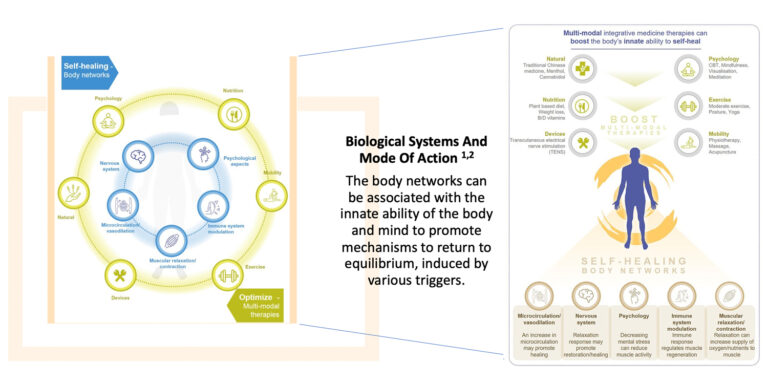When it comes to managing musculoskeletal pain – whether it’s low back pain (LBP), osteoarthritis (OA), or post-workout soreness – our first instinct is often to reach for painkillers in the medications cupboard in the bathroom, or buy some over-the-counter from the local pharmacy, or consult Dr Google or a real medical professional.
However, we have become too reliant on prescription medicines and over-the-counter painkillers. We desperately need alternative and drug-free solutions for pain management. But what if our bodies have an inheret and built-in capacity to heal without drugs? This concept of “self-healing” is gaining traction, and it‘s one that athletes and fitness enthusiasts should begin to pay serious attention to.
The “Self-Healing” Concept
Musculoskeletal (MSK) conditions, including LBP, OA and other forms of joint disease, affect millions of people globally and are leading causes of physical disability. Traditionally, treatments have focused on medications that relieve pain but often come with unwanted side effects. In contrast, “self-healing” shifts the focus to harnessing the body’s own repair systems – working in harmony with the body, not just against symptoms, but in concert with physiological repair systems. “Self-healing” involves activating five key body networks: the nervous system, psychological mechanisms, immune response, microcirculation, and muscle function. By tapping into these networks, the body can naturally manage pain, heal tissues, and restore physiological balance.
Integrating Self-Healing in Sports and Physical Exercise
For athletes and those leading an active lifestyle, understanding how to promote self-healing can potentially be a game-changer. Exercise, mental focus, and nutrition already play pivotal roles in muscle repair, but integrating self-healing strategies into your fitness routine can enhance recovery and prevent injury. Physical activity and improved circulation: Light, consistent exercise promotes blood flow, which carries oxygen and nutrients to tired and damaged tissues. Whether it’s stretching, yoga, or light cardiovascular work, maintaining circulation is key to promoting the self-healing process. Relaxation and nervous system activation: Engaging in activities like meditation, breathing exercises, or simply taking a break can activate the parasympathetic nervous system (the “rest and digest” system), which fosters cellular repair and tissue recovery. This is particularly useful after intense training sessions.
Mind-body exercises: Techniques like cognitive-behavioral therapy (CBT), visualization, and mindfulness reduce stress hormones, such as cortisol, and pro-inflammatory mediators which are known contributors to musculoskeletal degeneration and pain. Mental stress often manifests as muscle tension, and addressing this link through psychological strategies can enhance physical healing. Natural remedies and diet: Nutrition is another critical aspect of self-healing. A balanced diet rich in anti-inflammatory foods – like fruits, vegetables, and healthy fats – supports immune function and muscle recovery. Additionally, supplements like omega-3s and curcumin have shown promise in reducing pain and inflammation.
A Holistic Shift in Pain Management
For many years, MSK pain has been managed primarily through the use of prescription and over the counter pharmaceuticals, but the rise of self-healing suggests a broader, more integrative and multidisciplinary approach. Whether you’re an athlete recovering from an injury or dealing with chronic pain from LBP or OA, understanding the interplay between physical, mental, and immune health can significantly affect your healing journey. There is increasing evidence to support the integration of multidisciplinary and multimodal management for MSK pain. This creates a unique opportunity for healthcare professionals to come together and collaborate for the benefit of patients with MSK pain.
In conclusion, “self-healing” is more than just a concept – it‘s a call to action to optimize your body‘s natural, inherent and physiological capabilities. By incorporating multimodal and multidisciplinary strategies such as mental relaxation, proper circulation, immune support, and holistic remedies, you can achieve a more sustainable recovery, improve your performance, and lead a pain-free, active lifestyle.
References
1. McSwan J, et al. J Pain Res. 2021;14:2943-58;
2. Mobasheri A. J Pain Res. 2022;15:3479-82.
Autoren
is Professor of Musculoskeletal Biology in the Research Unit of Health Sciences and Technology, within the Faculty of Medicine at the University of Oulu in Finland. He is a Past President of the Osteoarthritis Research Society International (OARSI).




